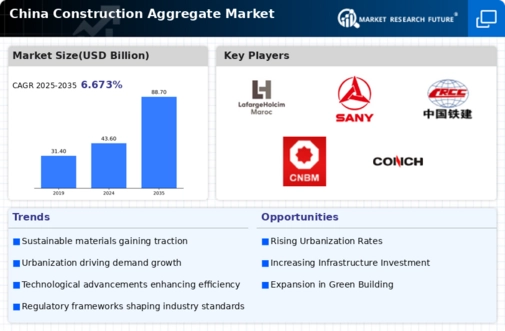Rising Urban Population
The construction aggregate market in China is experiencing a notable surge due to the increasing urban population. As urbanization continues, the demand for housing, commercial buildings, and infrastructure projects escalates. In 2025, urban areas in China are projected to house over 60% of the population, leading to a heightened need for construction materials. This demographic shift necessitates substantial investments in construction, thereby driving the demand for aggregates. the construction aggregate market is expected to grow alongside urban expansion, as local governments prioritize infrastructure development to accommodate the growing populace. Consequently, the market is likely to witness a compound annual growth rate (CAGR) of approximately 5% over the next few years, reflecting the critical role of urbanization in shaping the construction landscape.
Economic Growth and Investment
The construction aggregate market in China is poised for growth, largely due to the country's robust economic performance. With a GDP growth rate projected at around 6% in 2025, increased investments in construction and real estate are anticipated. This economic expansion is likely to fuel demand for construction aggregates, as both public and private sectors ramp up building activities. The real estate sector, in particular, is expected to contribute significantly to this demand, with new residential and commercial projects emerging across urban centers. Additionally, foreign investments in infrastructure projects may further bolster the construction aggregate market, as international firms seek to capitalize on China's growth potential. Overall, the economic landscape appears favorable for the construction aggregate market, suggesting a positive trajectory in the coming years.
Government Infrastructure Initiatives
The construction aggregate market in China is significantly influenced by government-led infrastructure initiatives. The Chinese government has committed to extensive infrastructure projects, including transportation networks, energy facilities, and urban development. In 2025, the government is expected to allocate over $200 billion towards infrastructure development, which will directly impact the demand for construction aggregates. These initiatives aim to enhance connectivity and stimulate economic growth, thereby creating a robust market for aggregates. Furthermore, the emphasis on sustainable infrastructure practices may lead to increased demand for recycled aggregates, presenting new opportunities within the construction aggregate market. As these projects unfold, the market is likely to experience sustained growth, driven by the government's strategic focus on infrastructure.
Technological Innovations in Production
Technological advancements in the production of construction aggregates are reshaping the market landscape in China. Innovations such as automated production processes and advanced crushing techniques are enhancing efficiency and reducing costs. In 2025, it is estimated that the adoption of these technologies could lead to a 15% increase in production capacity for aggregate manufacturers. Moreover, the integration of data analytics and artificial intelligence in supply chain management is optimizing logistics and distribution, further benefiting the construction aggregate market. These technological improvements not only streamline operations but also contribute to sustainability efforts by minimizing waste and energy consumption. As manufacturers embrace these innovations, the construction aggregate market is likely to evolve, becoming more competitive and responsive to market demands.
Environmental Regulations and Compliance
The construction aggregate market in China is increasingly shaped by stringent environmental regulations aimed at promoting sustainable practices. In 2025, the government is expected to enforce stricter compliance measures regarding the extraction and processing of aggregates. This regulatory landscape may compel companies to adopt eco-friendly practices, such as utilizing recycled materials and reducing carbon emissions. As a result, the market could witness a shift towards sustainable aggregate production methods, which may initially increase costs but ultimately lead to long-term benefits. Companies that proactively adapt to these regulations are likely to gain a competitive edge in the construction aggregate market. Furthermore, the emphasis on environmental stewardship may drive innovation in aggregate production, fostering a more sustainable industry overall.
















Leave a Comment